Dosing & Uses
Dosage Forms & Strengths
injectable solution
- 50mg/mL
- 250mg/mL
General Dosing
15 mg/kg/day divided IV/IM q8-12hr
Urinary Tract Infection
250 mg IV/IM q12hr
Extended Interval Dosing (q24 Hours)
First dose: 15 mg/kg IV based on lean body weight
Subsequent doses: consult pharmacist
Hospital Acquired Pneumonia
20 mg/kg/day IV; may administer with antipseudomonal beta-lactam or carbapenem
Dosage Modifications
Renal impairment
- CrCl >90 mL/min and aged <60 yr: q8hr
- CrCl 60-90 mL/min OR aged ≥60 yr: q12hr
- CrCl 25-60 mL/min: q24hr
- CrCl 10-25 mL/min: q48hr
- CrCl <10 mL/min: q72hr
- Administer after dialysis in ESRD
Limitation of use
Drug has only been studied in patients with refractory Mycobacterium avium complex (MAC) lung disease defined as patients who did not achieve negative sputum cultures after a minimum of 6 consecutive months of a multidrug background regimen therapy; use is not recommended for patients with nonrefractory MAC lung disease
Dosing Considerations
Monitor: peak, trough, renal & auditory function
Peak 15-40 mg/L, trough 5-10 mg/L
Mycobacterium Infections (Orphan)
Inhaled liposomal amikacin (Arikayce)
Orphan designation for treatment infections caused by nontuberculous mycobacteria
Sponsor
- Insmed Incorporated; Princeton Corporate Plaza IV, Suite C; Monmouth Junction, NJ 08852-1919
Pseudomonas aeruginosa Lung Infections (Orphan)
Orphan designation for management of P aeruginosa lung infections in patients with cystic fibrosis
Sponsor
- PlumeStars s.r.l.; Via Lago Scuro 11; 43124 Parma; Italy
Bronchopulmonary Pseudomonas aeruginosa (Orphan)
Inhaled liposomal amikacin (Arikayce)
Orphan designation for treatment of broncophulmonary P aeurginosa infections in cystic fibrosis
Administration: Inhalation NOTE: FDA imposed clinical hold on trials on August 1, 2011
Sponsor
- Insemed Inc; 11 Deer Park Drive, Suite 117; Monmouth Junction, NJ 08852
Bronchiectasis (Orphan)
Inhaled liposomal amikacin (Arikayce)
Orphan designation for treatment of bronchiectasis in patients with P aeurginosa infections or other susceptible microbial pathogens (eg, NTM)
Administration: Inhalation NOTE: FDA imposed clinical hold on trials on August 1, 2011
Sponsor
- Insemed Inc; 11 Deer Park Drive, Suite 117; Monmouth Junction, NJ 08852
Non-tuberculous Mycobacteria Infections (Orphan)
Encochleated amikacin product
Orphan designation for non-tuberculous mycobacteria (NTM) infections
Sponsor
- Aquarius Biotechnologies, Inc; 1545 U.S. 206; Bedminster Township, New Jersey 07921
Dosage Forms & Strengths
injectable solution
- 50mg/mL
- 250mg/mL
General Dosing
15-22.5 mg/kg/day IV/IM divided q8hr
Neonates
Aged ≤7 days
- ≤29 weeks gestational age: 18 mg/kg IV/IM q48hr
- 30-33 weeks gestational age: 18 mg/kg IV/IM q36hr
- ≥34 weeks gestational age: 15 mg/kg IV/IM q24hr
Aged >7 days
- 30-33 weeks gestational age: 15 mg/kg IV/IM q24hr
- ≥34 weeks gestational age: 15 mg/kg IV/IM q12-18hr
Aged 8-28 days old & <29 weeks gestational age
- 15 mg/kg IV/IM q36hr
- Also use this dose for the following: significant asphyxia, indomethacin for PDA, poor cardiac output, or renal impairment
Neonates Aged >28 days old & <29 weeks gestational age
Interactions
Interaction Checker
No Results

Contraindicated
Serious - Use Alternative
Significant - Monitor Closely
Minor

Contraindicated (3)
- amphotericin B deoxycholate
amikacin and amphotericin B deoxycholate both increase nephrotoxicity and/or ototoxicity. Contraindicated.
- cidofovir
amikacin and cidofovir both increase nephrotoxicity and/or ototoxicity. Contraindicated.
- neomycin PO
amikacin and neomycin PO both increase nephrotoxicity and/or ototoxicity. Contraindicated.
Serious - Use Alternative (22)
- atracurium
amikacin increases effects of atracurium by pharmacodynamic synergism. Avoid or Use Alternate Drug. Risk of apnea.
- bacitracin
amikacin and bacitracin both increase nephrotoxicity and/or ototoxicity. Avoid or Use Alternate Drug. Avoid concurrent use of bacitracin with other nephrotoxic drugs
- BCG vaccine live
amikacin decreases effects of BCG vaccine live by pharmacodynamic antagonism. Contraindicated. Wait until Abx Tx complete to administer live bacterial vaccine.
- bumetanide
bumetanide, amikacin. Either increases toxicity of the other by Mechanism: pharmacodynamic synergism. Avoid or Use Alternate Drug. Increased risk of ototoxicity and nephrotoxicity.
- cholera vaccine
amikacin, cholera vaccine. pharmacodynamic antagonism. Avoid or Use Alternate Drug. Avoid coadministration of cholera vaccine with systemic antibiotics since these agents may be active against the vaccine strain. Do not administer cholera vaccine to patients who have received oral or parenteral antibiotics within 14 days prior to vaccination.
- cisatracurium
amikacin increases effects of cisatracurium by pharmacodynamic synergism. Avoid or Use Alternate Drug. Risk of apnea.
- contrast media (iodinated)
amikacin and contrast media (iodinated) both increase nephrotoxicity and/or ototoxicity. Avoid or Use Alternate Drug.
- cyclosporine
amikacin and cyclosporine both increase nephrotoxicity and/or ototoxicity. Avoid or Use Alternate Drug.
- ethacrynic acid
ethacrynic acid, amikacin. Either increases toxicity of the other by Mechanism: pharmacodynamic synergism. Avoid or Use Alternate Drug. Increased risk of ototoxicity and nephrotoxicity.
- furosemide
furosemide, amikacin. Either increases toxicity of the other by Mechanism: pharmacodynamic synergism. Avoid or Use Alternate Drug. Increased risk of ototoxicity and nephrotoxicity.
- ioversol
amikacin and ioversol both increase nephrotoxicity and/or ototoxicity. Avoid or Use Alternate Drug.
- microbiota oral
amikacin decreases effects of microbiota oral by pharmacodynamic antagonism. Avoid or Use Alternate Drug. Microbiota oral contains bacterial spores. Antibacterial agents may decrease efficacy if coadministered. Complete antibiotic regimens 2-4 days before initiating microbiota oral. .
- pancuronium
amikacin increases effects of pancuronium by pharmacodynamic synergism. Avoid or Use Alternate Drug. Risk of apnea.
- quinidine
quinidine will increase the level or effect of amikacin by P-glycoprotein (MDR1) efflux transporter. Avoid or Use Alternate Drug.
- rapacuronium
amikacin increases effects of rapacuronium by pharmacodynamic synergism. Avoid or Use Alternate Drug. Risk of apnea.
- rocuronium
amikacin increases effects of rocuronium by pharmacodynamic synergism. Avoid or Use Alternate Drug. Risk of apnea.
- succinylcholine
amikacin increases effects of succinylcholine by pharmacodynamic synergism. Avoid or Use Alternate Drug. Risk of apnea.
- tacrolimus
amikacin and tacrolimus both increase nephrotoxicity and/or ototoxicity. Avoid or Use Alternate Drug.
- teicoplanin
amikacin and teicoplanin both increase nephrotoxicity and/or ototoxicity. Avoid or Use Alternate Drug.
- torsemide
torsemide, amikacin. Either increases toxicity of the other by Mechanism: pharmacodynamic synergism. Avoid or Use Alternate Drug. Increased risk of ototoxicity and nephrotoxicity.
- typhoid vaccine live
amikacin decreases effects of typhoid vaccine live by pharmacodynamic antagonism. Contraindicated. Wait until Abx Tx complete to administer live bacterial vaccine.
- vecuronium
amikacin increases effects of vecuronium by pharmacodynamic synergism. Avoid or Use Alternate Drug. Risk of apnea.
Monitor Closely (101)
- abobotulinumtoxinA
amikacin increases effects of abobotulinumtoxinA by pharmacodynamic synergism. Use Caution/Monitor. Aminoglycosides may potentiate botulinum toxin effects, which may result in excessive neuromuscular weakness and heighten systemic anticholinergic effects. .
- acyclovir
acyclovir and amikacin both increase nephrotoxicity and/or ototoxicity. Modify Therapy/Monitor Closely.
- adefovir
adefovir and amikacin both increase nephrotoxicity and/or ototoxicity. Use Caution/Monitor.
- amiodarone
amiodarone will increase the level or effect of amikacin by P-glycoprotein (MDR1) efflux transporter. Use Caution/Monitor.
- bazedoxifene/conjugated estrogens
amikacin will decrease the level or effect of bazedoxifene/conjugated estrogens by altering intestinal flora. Applies only to oral forms of hormone. Low risk of contraceptive failure. Use Caution/Monitor.
- capreomycin
amikacin and capreomycin both increase nephrotoxicity and/or ototoxicity. Modify Therapy/Monitor Closely.
- carboplatin
amikacin and carboplatin both increase nephrotoxicity and/or ototoxicity. Use Caution/Monitor.
- cefaclor
cefaclor increases toxicity of amikacin by nephrotoxicity and/or ototoxicity. Use Caution/Monitor. Cephalosporins may increase nephrotoxic effect of aminoglycosides. .
- cefadroxil
cefadroxil increases toxicity of amikacin by nephrotoxicity and/or ototoxicity. Use Caution/Monitor. Cephalosporins may increase nephrotoxic effect of aminoglycosides. .
- cefazolin
cefazolin increases toxicity of amikacin by nephrotoxicity and/or ototoxicity. Use Caution/Monitor. Cephalosporins may increase nephrotoxic effect of aminoglycosides. .
- cefdinir
cefdinir increases toxicity of amikacin by nephrotoxicity and/or ototoxicity. Use Caution/Monitor. Cephalosporins may increase nephrotoxic effect of aminoglycosides. .
- cefditoren
cefditoren increases toxicity of amikacin by nephrotoxicity and/or ototoxicity. Use Caution/Monitor. Cephalosporins may increase nephrotoxic effect of aminoglycosides. .
- cefepime
cefepime increases toxicity of amikacin by nephrotoxicity and/or ototoxicity. Use Caution/Monitor. Cephalosporins may increase nephrotoxic effect of aminoglycosides. .
- cefepime/enmetazobactam
cefepime/enmetazobactam increases toxicity of amikacin by nephrotoxicity and/or ototoxicity. Use Caution/Monitor. Cephalosporins may increase nephrotoxic effect of aminoglycosides.
- cefiderocol
cefiderocol increases toxicity of amikacin by nephrotoxicity and/or ototoxicity. Use Caution/Monitor. Cephalosporins may increase nephrotoxic effect of aminoglycosides. .
- cefixime
cefixime increases toxicity of amikacin by nephrotoxicity and/or ototoxicity. Use Caution/Monitor. Cephalosporins may increase nephrotoxic effect of aminoglycosides. .
- cefotaxime
cefotaxime increases toxicity of amikacin by nephrotoxicity and/or ototoxicity. Use Caution/Monitor. Cephalosporins may increase nephrotoxic effect of aminoglycosides. .
- cefotetan
cefotetan increases toxicity of amikacin by nephrotoxicity and/or ototoxicity. Use Caution/Monitor. Cephalosporins may increase nephrotoxic effect of aminoglycosides. .
- cefoxitin
cefoxitin increases toxicity of amikacin by nephrotoxicity and/or ototoxicity. Use Caution/Monitor. Cephalosporins may increase nephrotoxic effect of aminoglycosides. .
- cefpirome
cefpirome increases toxicity of amikacin by nephrotoxicity and/or ototoxicity. Use Caution/Monitor. Cephalosporins may increase nephrotoxic effect of aminoglycosides. .
- cefpodoxime
cefpodoxime increases toxicity of amikacin by nephrotoxicity and/or ototoxicity. Use Caution/Monitor. Cephalosporins may increase nephrotoxic effect of aminoglycosides. .
- cefprozil
cefprozil increases toxicity of amikacin by nephrotoxicity and/or ototoxicity. Use Caution/Monitor. Cephalosporins may increase nephrotoxic effect of aminoglycosides. .
- ceftaroline
ceftaroline increases toxicity of amikacin by nephrotoxicity and/or ototoxicity. Use Caution/Monitor. Cephalosporins may increase nephrotoxic effect of aminoglycosides. .
- ceftazidime
ceftazidime increases toxicity of amikacin by nephrotoxicity and/or ototoxicity. Use Caution/Monitor. Cephalosporins may increase nephrotoxic effect of aminoglycosides. .
- ceftazidime/avibactam
ceftazidime/avibactam increases toxicity of amikacin by nephrotoxicity and/or ototoxicity. Use Caution/Monitor. Cephalosporins may increase nephrotoxic effect of aminoglycosides. .
- ceftibuten
ceftibuten increases toxicity of amikacin by nephrotoxicity and/or ototoxicity. Use Caution/Monitor. Cephalosporins may increase nephrotoxic effect of aminoglycosides. .
- ceftizoxime
ceftizoxime increases toxicity of amikacin by nephrotoxicity and/or ototoxicity. Use Caution/Monitor. Cephalosporins may increase nephrotoxic effect of aminoglycosides. .
- ceftobiprole medocaril sodium
ceftobiprole medocaril sodium increases toxicity of amikacin by nephrotoxicity and/or ototoxicity. Use Caution/Monitor. Cephalosporins may increase nephrotoxic effect of aminoglycosides. .
- ceftolozane/tazobactam
ceftolozane/tazobactam increases toxicity of amikacin by nephrotoxicity and/or ototoxicity. Use Caution/Monitor. Cephalosporins may increase nephrotoxic effect of aminoglycosides. .
- ceftriaxone
ceftriaxone increases toxicity of amikacin by nephrotoxicity and/or ototoxicity. Use Caution/Monitor. Cephalosporins may increase nephrotoxic effect of aminoglycosides. .
- cefuroxime
cefuroxime increases toxicity of amikacin by nephrotoxicity and/or ototoxicity. Use Caution/Monitor. Cephalosporins may increase nephrotoxic effect of aminoglycosides. .
- cephalexin
cephalexin increases toxicity of amikacin by nephrotoxicity and/or ototoxicity. Use Caution/Monitor. Cephalosporins may increase nephrotoxic effect of aminoglycosides. .
- cephaloridine
amikacin and cephaloridine both increase nephrotoxicity and/or ototoxicity. Modify Therapy/Monitor Closely.
- cisplatin
amikacin and cisplatin both increase nephrotoxicity and/or ototoxicity. Use Caution/Monitor.
- clarithromycin
clarithromycin will increase the level or effect of amikacin by P-glycoprotein (MDR1) efflux transporter. Use Caution/Monitor.
- clotrimazole
clotrimazole will decrease the level or effect of amikacin by P-glycoprotein (MDR1) efflux transporter. Use Caution/Monitor.
- colistin
amikacin and colistin both increase nephrotoxicity and/or ototoxicity. Modify Therapy/Monitor Closely.
- conjugated estrogens
amikacin will decrease the level or effect of conjugated estrogens by altering intestinal flora. Applies only to oral forms of hormone. Low risk of contraceptive failure. Use Caution/Monitor.
- cyclosporine
cyclosporine will increase the level or effect of amikacin by P-glycoprotein (MDR1) efflux transporter. Use Caution/Monitor.
- daxibotulinumtoxinA
amikacin increases effects of daxibotulinumtoxinA by pharmacodynamic synergism. Use Caution/Monitor. Aminoglycosides may potentiate botulinum toxin effects, which may result in excessive neuromuscular weakness and heighten systemic anticholinergic effects. .
- deferasirox
deferasirox, amikacin. Other (see comment). Use Caution/Monitor. Comment: Acute renal failure has been reported during treatment with deferasirox. Coadministration of deferasirox with other potentially nephrotoxic drugs, including aminoglycosides, may increase the risk of this toxicity. Monitor serum creatinine and/or creatinine clearance in patients who are receiving deferasirox and nephrotoxic drugs concomitantly.
- dienogest/estradiol valerate
amikacin will decrease the level or effect of dienogest/estradiol valerate by altering intestinal flora. Applies only to oral forms of hormone. Low risk of contraceptive failure. Use Caution/Monitor. An alternate or additional form of birth control may be advisable during concomitant use.
- digoxin
amikacin will increase the level or effect of digoxin by altering intestinal flora. Applies only to oral form of both agents. Use Caution/Monitor.
- dronedarone
dronedarone will increase the level or effect of amikacin by P-glycoprotein (MDR1) efflux transporter. Use Caution/Monitor.
- elvitegravir/cobicistat/emtricitabine/tenofovir DF
amikacin and elvitegravir/cobicistat/emtricitabine/tenofovir DF both increase nephrotoxicity and/or ototoxicity. Use Caution/Monitor.
- erythromycin base
erythromycin base will increase the level or effect of amikacin by P-glycoprotein (MDR1) efflux transporter. Use Caution/Monitor.
- erythromycin ethylsuccinate
erythromycin ethylsuccinate will increase the level or effect of amikacin by P-glycoprotein (MDR1) efflux transporter. Use Caution/Monitor.
- erythromycin lactobionate
erythromycin lactobionate will increase the level or effect of amikacin by P-glycoprotein (MDR1) efflux transporter. Use Caution/Monitor.
- erythromycin stearate
erythromycin stearate will increase the level or effect of amikacin by P-glycoprotein (MDR1) efflux transporter. Use Caution/Monitor.
- estradiol
amikacin will decrease the level or effect of estradiol by altering intestinal flora. Applies only to oral forms of hormone. Low risk of contraceptive failure. Use Caution/Monitor.
- estrogens conjugated synthetic
amikacin will decrease the level or effect of estrogens conjugated synthetic by altering intestinal flora. Applies only to oral forms of hormone. Low risk of contraceptive failure. Use Caution/Monitor.
- estropipate
amikacin will decrease the level or effect of estropipate by altering intestinal flora. Applies only to oral forms of hormone. Low risk of contraceptive failure. Use Caution/Monitor.
- felodipine
felodipine will increase the level or effect of amikacin by P-glycoprotein (MDR1) efflux transporter. Use Caution/Monitor.
- foscarnet
amikacin and foscarnet both increase nephrotoxicity and/or ototoxicity. Use Caution/Monitor.
- fosphenytoin
fosphenytoin will decrease the level or effect of amikacin by P-glycoprotein (MDR1) efflux transporter. Use Caution/Monitor.
- gentamicin
amikacin and gentamicin both increase nephrotoxicity and/or ototoxicity. Modify Therapy/Monitor Closely.
- ibuprofen
ibuprofen increases levels of amikacin by decreasing renal clearance. Use Caution/Monitor. Interaction mainly occurs in preterm infants.
- ibuprofen IV
ibuprofen IV increases levels of amikacin by decreasing renal clearance. Use Caution/Monitor. Interaction mainly occurs in preterm infants.
- incobotulinumtoxinA
amikacin increases effects of incobotulinumtoxinA by pharmacodynamic synergism. Use Caution/Monitor. Aminoglycosides may potentiate botulinum toxin effects, which may result in excessive neuromuscular weakness and heighten systemic anticholinergic effects. .
- indinavir
indinavir will increase the level or effect of amikacin by P-glycoprotein (MDR1) efflux transporter. Use Caution/Monitor.
- ketoconazole
ketoconazole will increase the level or effect of amikacin by P-glycoprotein (MDR1) efflux transporter. Use Caution/Monitor.
- letibotulinumtoxinA
amikacin increases effects of letibotulinumtoxinA by pharmacodynamic synergism. Use Caution/Monitor. Aminoglycosides may potentiate botulinum toxin effects, which may result in excessive neuromuscular weakness and heighten systemic anticholinergic effects. .
- levoketoconazole
levoketoconazole will increase the level or effect of amikacin by P-glycoprotein (MDR1) efflux transporter. Use Caution/Monitor.
- loratadine
loratadine will increase the level or effect of amikacin by P-glycoprotein (MDR1) efflux transporter. Use Caution/Monitor.
- magnesium supplement
magnesium supplement, amikacin. Either increases toxicity of the other by pharmacodynamic synergism. Use Caution/Monitor. Each enhance the neuromuscular blocking effect of the other; may have negative respiratory effects.
- mestranol
amikacin will decrease the level or effect of mestranol by altering intestinal flora. Applies only to oral forms of hormone. Low risk of contraceptive failure. Use Caution/Monitor.
- methoxyflurane
amikacin and methoxyflurane both increase nephrotoxicity and/or ototoxicity. Use Caution/Monitor.
- nefazodone
nefazodone will increase the level or effect of amikacin by P-glycoprotein (MDR1) efflux transporter. Use Caution/Monitor.
- nicardipine
nicardipine will increase the level or effect of amikacin by P-glycoprotein (MDR1) efflux transporter. Use Caution/Monitor.
- nifedipine
nifedipine will decrease the level or effect of amikacin by P-glycoprotein (MDR1) efflux transporter. Use Caution/Monitor.
- nilotinib
nilotinib will increase the level or effect of amikacin by P-glycoprotein (MDR1) efflux transporter. Use Caution/Monitor.
- onabotulinumtoxinA
amikacin increases effects of onabotulinumtoxinA by pharmacodynamic synergism. Use Caution/Monitor. Aminoglycosides may potentiate botulinum toxin effects, which may result in excessive neuromuscular weakness and heighten systemic anticholinergic effects. .
- oxaliplatin
amikacin and oxaliplatin both increase nephrotoxicity and/or ototoxicity. Use Caution/Monitor.
- paromomycin
amikacin and paromomycin both increase nephrotoxicity and/or ototoxicity. Use Caution/Monitor.
- pentamidine
amikacin and pentamidine both increase nephrotoxicity and/or ototoxicity. Use Caution/Monitor.
- peramivir
amikacin increases levels of peramivir by decreasing renal clearance. Use Caution/Monitor. Caution when peramivir coadministered with nephrotoxic drugs.
- phenobarbital
phenobarbital will decrease the level or effect of amikacin by P-glycoprotein (MDR1) efflux transporter. Use Caution/Monitor.
- phenytoin
phenytoin will decrease the level or effect of amikacin by P-glycoprotein (MDR1) efflux transporter. Use Caution/Monitor.
- polymyxin B
amikacin and polymyxin B both increase nephrotoxicity and/or ototoxicity. Modify Therapy/Monitor Closely.
- prabotulinumtoxinA
amikacin increases effects of prabotulinumtoxinA by pharmacodynamic synergism. Use Caution/Monitor. Aminoglycosides may potentiate botulinum toxin effects, which may result in excessive neuromuscular weakness and heighten systemic anticholinergic effects. .
- quercetin
quercetin will decrease the level or effect of amikacin by P-glycoprotein (MDR1) efflux transporter. Use Caution/Monitor.
- rifampin
rifampin will decrease the level or effect of amikacin by P-glycoprotein (MDR1) efflux transporter. Use Caution/Monitor.
- rimabotulinumtoxinB
amikacin increases effects of rimabotulinumtoxinB by pharmacodynamic synergism. Use Caution/Monitor. Aminoglycosides may potentiate botulinum toxin effects, which may result in excessive neuromuscular weakness and heighten systemic anticholinergic effects. .
- ritonavir
ritonavir will increase the level or effect of amikacin by P-glycoprotein (MDR1) efflux transporter. Use Caution/Monitor.
- sirolimus
sirolimus will increase the level or effect of amikacin by P-glycoprotein (MDR1) efflux transporter. Use Caution/Monitor.
- sodium picosulfate/magnesium oxide/anhydrous citric acid
amikacin decreases effects of sodium picosulfate/magnesium oxide/anhydrous citric acid by altering metabolism. Use Caution/Monitor. Coadministration with antibiotics decreases efficacy by altering colonic bacterial flora needed to convert sodium picosulfate to active drug.
- sodium sulfate/?magnesium sulfate/potassium chloride
sodium sulfate/?magnesium sulfate/potassium chloride increases toxicity of amikacin by Other (see comment). Use Caution/Monitor. Comment: Coadministration with medications that cause fluid and electrolyte abnormalities may increase the risk of adverse events of seizure, arrhythmias, and renal impairment.
- sodium sulfate/potassium sulfate/magnesium sulfate
sodium sulfate/potassium sulfate/magnesium sulfate increases toxicity of amikacin by Other (see comment). Use Caution/Monitor. Comment: Coadministration with medications that cause fluid and electrolyte abnormalities may increase the risk of adverse events of seizure, arrhythmias, and renal impairment.
- St John's Wort
St John's Wort will decrease the level or effect of amikacin by P-glycoprotein (MDR1) efflux transporter. Use Caution/Monitor.
- streptomycin
amikacin and streptomycin both increase nephrotoxicity and/or ototoxicity. Use Caution/Monitor.
- streptozocin
amikacin and streptozocin both increase nephrotoxicity and/or ototoxicity. Use Caution/Monitor.
- tacrolimus
tacrolimus will increase the level or effect of amikacin by P-glycoprotein (MDR1) efflux transporter. Use Caution/Monitor.
- tenofovir DF
amikacin and tenofovir DF both increase nephrotoxicity and/or ototoxicity. Use Caution/Monitor.
amikacin increases levels of tenofovir DF by decreasing elimination. Use Caution/Monitor. - tobramycin
amikacin and tobramycin both increase nephrotoxicity and/or ototoxicity. Modify Therapy/Monitor Closely.
- tobramycin inhaled
tobramycin inhaled and amikacin both increase nephrotoxicity and/or ototoxicity. Modify Therapy/Monitor Closely. Avoid concurrent or sequential use to decrease risk for ototoxicity
- tolvaptan
tolvaptan will increase the level or effect of amikacin by P-glycoprotein (MDR1) efflux transporter. Use Caution/Monitor.
- trazodone
trazodone will decrease the level or effect of amikacin by P-glycoprotein (MDR1) efflux transporter. Use Caution/Monitor.
- trimagnesium citrate anhydrous
amikacin, trimagnesium citrate anhydrous. Either increases effects of the other by Other (see comment). Use Caution/Monitor. Comment: Coadministration of aminoglycosides with magnesium may increase risk of neuromuscular weakness and paralysis.
- vancomycin
amikacin and vancomycin both increase nephrotoxicity and/or ototoxicity. Use Caution/Monitor.
- verapamil
verapamil will increase the level or effect of amikacin by P-glycoprotein (MDR1) efflux transporter. Use Caution/Monitor.
- voclosporin
voclosporin, amikacin. Either increases toxicity of the other by nephrotoxicity and/or ototoxicity. Modify Therapy/Monitor Closely. Coadministration with drugs associated with nephrotoxicity may increase the risk for acute and/or chronic nephrotoxicity.
Minor (62)
- aceclofenac
aceclofenac increases levels of amikacin by decreasing renal clearance. Minor/Significance Unknown. Interaction mainly occurs in preterm infants.
- acemetacin
acemetacin increases levels of amikacin by decreasing renal clearance. Minor/Significance Unknown. Interaction mainly occurs in preterm infants.
- aspirin
aspirin increases levels of amikacin by decreasing renal clearance. Minor/Significance Unknown. Interaction mainly occurs in preterm infants.
- aspirin rectal
aspirin rectal increases levels of amikacin by decreasing renal clearance. Minor/Significance Unknown. Interaction mainly occurs in preterm infants.
- aspirin/citric acid/sodium bicarbonate
aspirin/citric acid/sodium bicarbonate increases levels of amikacin by decreasing renal clearance. Minor/Significance Unknown. Interaction mainly occurs in preterm infants.
- aztreonam
aztreonam, amikacin. Either increases effects of the other by pharmacodynamic synergism. Minor/Significance Unknown. Combination may be used synergistically against Pseudomonas spp. and Enterobacteriaceae.
- balsalazide
amikacin will decrease the level or effect of balsalazide by altering intestinal flora. Applies only to oral form of both agents. Minor/Significance Unknown.
- biotin
amikacin will decrease the level or effect of biotin by altering intestinal flora. Applies only to oral form of both agents. Minor/Significance Unknown.
- calcium acetate
amikacin decreases levels of calcium acetate by inhibition of GI absorption. Applies only to oral form of both agents. Minor/Significance Unknown.
- calcium carbonate
amikacin decreases levels of calcium carbonate by inhibition of GI absorption. Applies only to oral form of both agents. Minor/Significance Unknown.
- calcium chloride
amikacin decreases levels of calcium chloride by inhibition of GI absorption. Applies only to oral form of both agents. Minor/Significance Unknown.
- calcium citrate
amikacin decreases levels of calcium citrate by inhibition of GI absorption. Applies only to oral form of both agents. Minor/Significance Unknown.
- calcium gluconate
amikacin decreases levels of calcium gluconate by inhibition of GI absorption. Applies only to oral form of both agents. Minor/Significance Unknown.
- celecoxib
celecoxib increases levels of amikacin by decreasing renal clearance. Minor/Significance Unknown. Interaction mainly occurs in preterm infants.
- choline magnesium trisalicylate
choline magnesium trisalicylate increases levels of amikacin by decreasing renal clearance. Minor/Significance Unknown. Interaction mainly occurs in preterm infants.
- clotrimazole
clotrimazole decreases levels of amikacin by unknown mechanism. Minor/Significance Unknown.
- cordyceps
cordyceps decreases toxicity of amikacin by unspecified interaction mechanism. Minor/Significance Unknown.
- cyanocobalamin
amikacin decreases levels of cyanocobalamin by inhibition of GI absorption. Applies only to oral form of both agents. Minor/Significance Unknown.
- diclofenac
diclofenac increases levels of amikacin by decreasing renal clearance. Minor/Significance Unknown. Interaction mainly occurs in preterm infants.
- diflunisal
diflunisal increases levels of amikacin by decreasing renal clearance. Minor/Significance Unknown. Interaction mainly occurs in preterm infants.
- entecavir
amikacin, entecavir. Either increases effects of the other by decreasing renal clearance. Minor/Significance Unknown. Coadministration with drugs that reduce renal function or compete for active tubular secretion may increase serum concentrations of either entecavir or the coadministered drug.
- etodolac
etodolac increases levels of amikacin by decreasing renal clearance. Minor/Significance Unknown. Interaction mainly occurs in preterm infants.
- fenoprofen
fenoprofen increases levels of amikacin by decreasing renal clearance. Minor/Significance Unknown. Interaction mainly occurs in preterm infants.
- fluconazole
fluconazole decreases levels of amikacin by unknown mechanism. Minor/Significance Unknown.
- flurbiprofen
flurbiprofen increases levels of amikacin by decreasing renal clearance. Minor/Significance Unknown. Interaction mainly occurs in preterm infants.
- indomethacin
indomethacin increases levels of amikacin by decreasing renal clearance. Minor/Significance Unknown. Interaction mainly occurs in preterm infants.
- ketoconazole
ketoconazole decreases levels of amikacin by unknown mechanism. Minor/Significance Unknown.
- ketoprofen
ketoprofen increases levels of amikacin by decreasing renal clearance. Minor/Significance Unknown. Interaction mainly occurs in preterm infants.
- ketorolac
ketorolac increases levels of amikacin by decreasing renal clearance. Minor/Significance Unknown. Interaction mainly occurs in preterm infants.
- ketorolac intranasal
ketorolac intranasal increases levels of amikacin by decreasing renal clearance. Minor/Significance Unknown. Interaction mainly occurs in preterm infants.
- levoketoconazole
levoketoconazole decreases levels of amikacin by unknown mechanism. Minor/Significance Unknown.
- lornoxicam
lornoxicam increases levels of amikacin by decreasing renal clearance. Minor/Significance Unknown. Interaction mainly occurs in preterm infants.
- magnesium chloride
amikacin decreases levels of magnesium chloride by increasing renal clearance. Minor/Significance Unknown.
- magnesium citrate
amikacin decreases levels of magnesium citrate by increasing renal clearance. Minor/Significance Unknown.
- magnesium hydroxide
amikacin decreases levels of magnesium hydroxide by increasing renal clearance. Minor/Significance Unknown.
- magnesium oxide
amikacin decreases levels of magnesium oxide by increasing renal clearance. Minor/Significance Unknown.
- magnesium sulfate
amikacin decreases levels of magnesium sulfate by increasing renal clearance. Minor/Significance Unknown.
- meclizine
meclizine, amikacin. Mechanism: unspecified interaction mechanism. Minor/Significance Unknown. Ototoxicity of aminoglycoside may be masked.
- meclofenamate
meclofenamate increases levels of amikacin by decreasing renal clearance. Minor/Significance Unknown. Interaction mainly occurs in preterm infants.
- mefenamic acid
mefenamic acid increases levels of amikacin by decreasing renal clearance. Minor/Significance Unknown. Interaction mainly occurs in preterm infants.
- meloxicam
meloxicam increases levels of amikacin by decreasing renal clearance. Minor/Significance Unknown. Interaction mainly occurs in preterm infants.
- miconazole vaginal
miconazole vaginal decreases levels of amikacin by unknown mechanism. Minor/Significance Unknown.
- nabumetone
nabumetone increases levels of amikacin by decreasing renal clearance. Minor/Significance Unknown. Interaction mainly occurs in preterm infants.
- naproxen
naproxen increases levels of amikacin by decreasing renal clearance. Minor/Significance Unknown. Interaction mainly occurs in preterm infants.
- oxaprozin
oxaprozin increases levels of amikacin by decreasing renal clearance. Minor/Significance Unknown. Interaction mainly occurs in preterm infants.
- pantothenic acid
amikacin will decrease the level or effect of pantothenic acid by altering intestinal flora. Applies only to oral form of both agents. Minor/Significance Unknown.
- parecoxib
parecoxib increases levels of amikacin by decreasing renal clearance. Minor/Significance Unknown. Interaction mainly occurs in preterm infants.
- piperacillin
piperacillin increases effects of amikacin by pharmacodynamic synergism. Minor/Significance Unknown.
- piroxicam
piroxicam increases levels of amikacin by decreasing renal clearance. Minor/Significance Unknown. Interaction mainly occurs in preterm infants.
- posaconazole
posaconazole decreases levels of amikacin by unknown mechanism. Minor/Significance Unknown.
- pyridoxine
amikacin will decrease the level or effect of pyridoxine by altering intestinal flora. Applies only to oral form of both agents. Minor/Significance Unknown.
- pyridoxine (Antidote)
amikacin will decrease the level or effect of pyridoxine (Antidote) by altering intestinal flora. Applies only to oral form of both agents. Minor/Significance Unknown.
- salicylates (non-asa)
salicylates (non-asa) increases levels of amikacin by decreasing renal clearance. Minor/Significance Unknown. Interaction mainly occurs in preterm infants.
- salsalate
salsalate increases levels of amikacin by decreasing renal clearance. Minor/Significance Unknown. Interaction mainly occurs in preterm infants.
- sulfasalazine
sulfasalazine increases levels of amikacin by decreasing renal clearance. Minor/Significance Unknown. Interaction mainly occurs in preterm infants.
- sulindac
sulindac increases levels of amikacin by decreasing renal clearance. Minor/Significance Unknown. Interaction mainly occurs in preterm infants.
- thiamine
amikacin will decrease the level or effect of thiamine by altering intestinal flora. Applies only to oral form of both agents. Minor/Significance Unknown.
- ticarcillin
ticarcillin decreases effects of amikacin by altering metabolism. Minor/Significance Unknown. Increased risk in renal impairment.
- tolfenamic acid
tolfenamic acid increases levels of amikacin by decreasing renal clearance. Minor/Significance Unknown. Interaction mainly occurs in preterm infants.
- tolmetin
tolmetin increases levels of amikacin by decreasing renal clearance. Minor/Significance Unknown. Interaction mainly occurs in preterm infants.
- voriconazole
voriconazole decreases levels of amikacin by unknown mechanism. Minor/Significance Unknown.
- zoledronic acid
amikacin, zoledronic acid. Mechanism: pharmacodynamic synergism. Minor/Significance Unknown. Additive hypocalcemia.
Adverse Effects
1-10%
Neurotoxicity
Nephrotoxicity (if trough >10 mg/L)
Ototoxicity
<1%
Hypotension
Headache
Drug fever
Rash
Nausea
Vomiting
Eosinophilia
Paresthesia
Tremor
Arthralgia
Weakness
Allergic reaction
Postmarketing Reports
Limitation of use
Immune system disorders: Hypersensitivity, anaphylaxis
Warnings
Black Box Warnings
Neurotoxicity, manifested as both bilateral auditory and vestibular ototoxicity, can occur in patients with preexisting renal damage and in patients with normal renal function treated at higher doses and/or for periods longer than those recommended. High-frequency deafness usually occurs first and can be detected only by audiometric testing
Vertigo may occur and may be evidence of vestibular injury
Aminoglycosides are potentially nephrotoxic
Risk is greater in patients with impaired renal function and in those who receive high doses or prolonged therapy. Rarely, nephrotoxicity may not become apparent until the first few days after cessation of therapy
Use with caution in premature infants and neonates because of renal immaturity and the resulting prolongation of serum half-life of the drug
Neuromuscular blockade and respiratory paralysis have been reported following parenteral injection, topical instillation (as in orthopedic and abdominal irrigation or in local treatment of empyema), and oral use of aminoglycosides, especially when given soon after anesthesia or muscle relaxants
If blockage occurs, calcium salts may reverse these phenomena, but mechanical respiratory assistance may be necessary
Avoid concurrent or sequential use of neurotoxic and/or nephrotoxic drugs including other aminoglycosides (eg, amikacin, streptomycin, neomycin, kanamycin, gentamicin, paromomycin
Cumulative listing of drugs to avoid from all aminoglycoside package inserts include amphotericin B, bacitracin, cephaloridine, cisplatin, colistin, polymyxin B, vancomycin, and viomycin
Avoid potent diuretics (eg, ethacrynic acid, furosemide) because they increase risk of ototoxicity
When administered intravenously, diuretics may enhance aminoglycoside toxicity by altering antibiotic concentrations in serum and tissue
Contraindications
Documented hypersensitivity
Cautions
Caution in patients with renal impairment
Not intended for long-term therapy; caution in patients with renal failure (not on dialysis), hypocalcemia, myasthenia gravis, and conditions that depress neuromuscular transmission
Serious and potentially life-threatening hypersensitivity reactions, including anaphylaxis, reported; before therapy instituted, evaluate for previous hypersensitivity reactions to aminoglycosides; if anaphylaxis or a hypersensitivity reaction occurs, discontinue therapy and institute appropriate supportive measures
Hypersensitivity pneumonitis reported; if hypersensitivity pneumonitis occurs, discontinue therapy and manage patients as medically appropriate
Higher frequency of hemoptysis and bronchospasm, reported with treatment; if these occur, manage patients as medically appropriate
Aminoglycosides can cause nephrotoxicity; close monitoring of patients with known or suspected renal dysfunction may be needed when prescribing drug
Higher frequency of ototoxicity reported with treatment; closely monitor patients with known or suspected auditory or vestibular dysfunction; if patients develop tinnitus this may be an early symptom of ototoxicity
Aminoglycosides may aggravate muscle weakness because of a potential curare-like effect on neuromuscular function; if neuromuscular blockade occurs, it may be reversed by the administration of calcium salts, but mechanical assistance may be necessary
Higher frequency of exacerbations of underlying pulmonary disease reported with treatment; treat patients as medically appropriate if this occurs
Aminoglycosides can cause total, irreversible, bilateral congenital deafness in pediatric patients exposed in utero
Pregnancy & Lactation
Pregnancy Category: D
Lactation: excretion in milk unknown/not recommended
Pregnancy Categories
A: Generally acceptable. Controlled studies in pregnant women show no evidence of fetal risk.
B: May be acceptable. Either animal studies show no risk but human studies not available or animal studies showed minor risks and human studies done and showed no risk. C: Use with caution if benefits outweigh risks. Animal studies show risk and human studies not available or neither animal nor human studies done. D: Use in LIFE-THREATENING emergencies when no safer drug available. Positive evidence of human fetal risk. X: Do not use in pregnancy. Risks involved outweigh potential benefits. Safer alternatives exist. NA: Information not available.Pharmacology
Mechanism of Action
Irreversibly binds to 30S subunit of bacterial ribosomes; blocks recognition step in protein synthesis; causes growth inhibition. For gram-negative bacterial coverage of infections resistant to gentamicin and tobramycin
Absorption
IM absorption: May be delayed in bedridden patient
Peak plasma time, IM: 45-120 min
Distribution
Protein bound: 0-11%
Vd: 0.25-0.4 L/kg, primarily into extracellular fluid (highly hydrophilic); penetrates blood-brain barrier when meninges inflamed; crosses placenta, relative diffusion of antimicrobial agents from blood into CSF: good only with inflammation (exceeds usual MICs)
Elimination
Half-Life: 2-3 hr (normal renal function)
Excretion: urine (94-98%)
Dialyzable: HD: yes; PD: yes
Administration
IV Incompatibilities
Additive: aminophylline in dextrose-containing diluents, amphotericin B, ampicillin, cefazolin, cefotaxime(?), ceftazidime, chloramphenicol, chlorothiazide, heparin, phenytoin, thiopental, vitamin B/C
Syringe: heparin
Y-site: allopurinol, amphotericin B cholesteryl sulfate, azithromycin, hetastarch, propofol
IV Compatibilities
Solution: compatible with most common solvents
Additive (partial list): aminophylline (in LR, NS, Ringer's, Na-Lactate 1/6M), ascorbic acid, CaCl2, cefepime, ceftriaxone, ciprofloxacin, clindamycin, dexamethasone Na-phosphate(? may be conc-dep), diphenhydramine, fluconazole, furosemide, metronidazole, prochlorperazine, promethazine, NaHCO3, KCl (may not be in dextran6%/NS), succinylcholine, vancomycin
Syringe: caffeine, clindamycin, doxapram
Y-site (partial list): acyclovir, amiodarone, diltiazem, enalaprilat, fluconazole, furosemide, levofloxacin, linezolid, lorazepam, MgSO4, midazolam, milrinone, morphine, ondansetron, warfarin, zidovudine
IV Preparation
Dilute 500 mg to 100 or 200 mL sterile diluent (0.9% NaCl or D5W)
IV/IM Administration
IM: Administer undiluted to upper outer quadrant of buttocks
IV: Infuse over 30-60 min in adults and children; infuse over 1-2 hr in infants
Images
| BRAND | FORM. | UNIT PRICE | PILL IMAGE |
|---|---|---|---|
| amikacin injection - | 1,000 mg/4 mL vial | 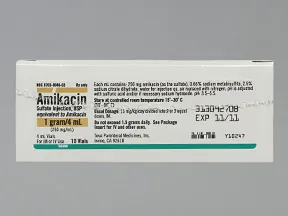 | |
| amikacin injection - | 500 mg/2 mL vial | 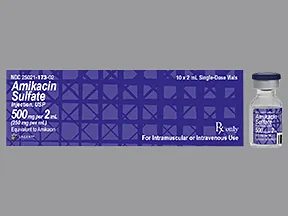 | |
| amikacin injection - | 1,000 mg/4 mL vial | 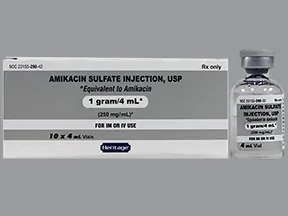 | |
| amikacin injection - | 500 mg/2 mL vial | 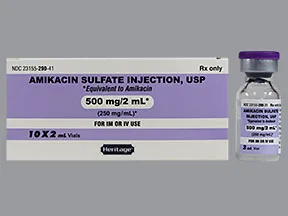 | |
| amikacin injection - | 1,000 mg/4 mL vial | 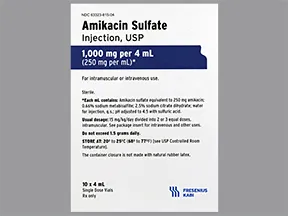 | |
| amikacin injection - | 1,000 mg/4 mL vial | 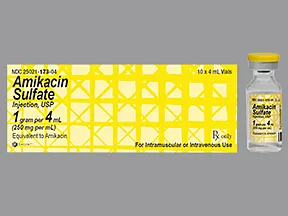 | |
| amikacin injection - | 1,000 mg/4 mL vial | 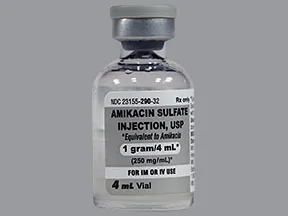 | |
| amikacin injection - | 500 mg/2 mL vial |  | |
| amikacin injection - | 500 mg/2 mL vial | 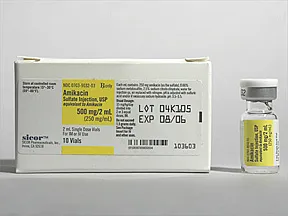 | |
| amikacin injection - | 500 mg/2 mL vial |  | |
| amikacin injection - | 500 mg/2 mL vial | 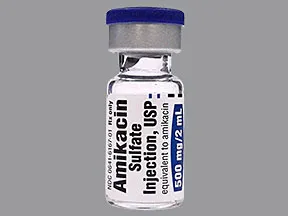 | |
| amikacin injection - | 1,000 mg/4 mL vial | 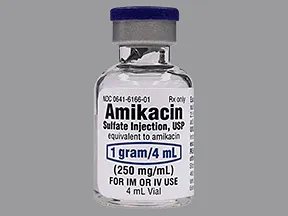 |
Copyright © 2010 First DataBank, Inc.
Patient Handout
amikacin injection
AMIKACIN - INJECTION
(A-mi-KAY-sin)
COMMON BRAND NAME(S): Amikin
WARNING: This medication can cause serious kidney problems and nerve damage, resulting in permanent hearing loss (including deafness or decreased hearing) and balance problems. The risk is increased if you are older, already have kidney disease, or if you have a severe loss of body water (dehydration). Your risk is also increased if you receive high doses, or with longer use of this medication.Tell your doctor right away if you notice ringing/roaring sounds in the ears, hearing loss, dizziness, or an unusual decrease in the amount of your urine.Careful monitoring by your doctor will reduce the risk of these side effects. Monitoring may include hearing, kidney, urine, and drug blood level tests.Avoid other medications that may increase your risk for these serious side effects if taken together with amikacin. See also Drug Interactions section.
USES: This medication is used to prevent or treat a wide variety of bacterial infections. Amikacin belongs to a class of drugs known as aminoglycoside antibiotics. It works by stopping the growth of bacteria.
HOW TO USE: This medication is given by injection into a vein or muscle. It is given as directed by your doctor, usually every 8 hours. The dosage is based on your medical condition, weight, lab tests, and response to treatment.If you are giving this medication to yourself at home, learn all preparation and usage instructions from your health care professional. Before using, check this product visually for particles or discoloration. If either is present, do not use the liquid. Learn how to store and discard medical supplies safely.For the best effect, use this antibiotic at evenly spaced times. To help you remember, use this medication at the same time(s) every day.Continue to use this medication until the full prescribed amount is finished, even if symptoms disappear after a few days. Stopping the medication too early may result in a return of the infection.Tell your doctor if your condition lasts or gets worse.
SIDE EFFECTS: See also Warning section.Nausea, vomiting, stomach upset, or loss of appetite may occur. Pain/irritation/redness at the injection site may rarely occur. If any of these effects last or get worse, tell your doctor or pharmacist promptly.Remember that this medication has been prescribed because your doctor has judged that the benefit to you is greater than the risk of side effects. Many people using this medication do not have serious side effects.Tell your doctor right away if you have any serious side effects, including: numbness/tingling, muscle twitching or weakness, seizure.This medication may rarely cause a severe intestinal condition due to a bacteria called C. difficile. This condition may occur during treatment or weeks to months after treatment has stopped. Tell your doctor right away if you develop: diarrhea that doesn't stop, abdominal or stomach pain/cramping, blood/mucus in your stool.If you have these symptoms, do not use anti-diarrhea or opioid products because they may make symptoms worse.Use of this medication for prolonged or repeated periods may result in oral thrush or a new yeast infection. Contact your doctor if you notice white patches in your mouth, a change in vaginal discharge, or other new symptoms.A very serious allergic reaction to this drug is rare. However, get medical help right away if you notice any symptoms of a serious allergic reaction, including: rash, itching/swelling (especially of the face/tongue/throat), severe dizziness, trouble breathing.This is not a complete list of possible side effects. If you notice other effects not listed above, contact your doctor or pharmacist.In the US -Call your doctor for medical advice about side effects. You may report side effects to FDA at 1-800-FDA-1088 or at www.fda.gov/medwatch.In Canada - Call your doctor for medical advice about side effects. You may report side effects to Health Canada at 1-866-234-2345.
PRECAUTIONS: Before using amikacin, tell your doctor or pharmacist if you are allergic to it; or to other aminoglycoside antibiotics (such as gentamicin, tobramycin); or if you have any other allergies. This product may contain inactive ingredients (such as sulfites), which can cause allergic reactions or other problems. Talk to your pharmacist for more details.Before using this medication, tell your doctor or pharmacist your medical history, especially of: cystic fibrosis, hearing problems (including deafness, decreased hearing), kidney problems, low blood minerals (including potassium, magnesium, calcium), myasthenia gravis, Parkinson's disease.Amikacin may cause live bacterial vaccines (such as typhoid vaccine) to not work well. Tell your health care professional that you are using amikacin before having any immunizations/vaccinations.Before having surgery, tell your doctor or dentist about all the products you use (including prescription drugs, nonprescription drugs, and herbal products).Older adults may be more sensitive to the effects of this drug, especially kidney damage.This medication is not recommended for use during pregnancy. Although there have been reports of harm in babies born to women using similar drugs, there have not been reports of harm in babies born to women using amikacin. Discuss the risks and benefits with your doctor.This drug passes into breast milk in small amounts. However, many doctors consider breastfeeding safe while using this medication. Consult your doctor before breastfeeding.
DRUG INTERACTIONS: See also Warning section.Drug interactions may change how your medications work or increase your risk for serious side effects. This document does not contain all possible drug interactions. Keep a list of all the products you use (including prescription/nonprescription drugs and herbal products) and share it with your doctor and pharmacist. Do not start, stop, or change the dosage of any medicines without your doctor's approval.Other medications that may affect the kidneys or hearing may increase the risk of kidney damage or hearing loss if taken with amikacin. Some examples include: amphotericin B, cidofovir, cisplatin, polymyxin B, tobramycin, cephalosporins such as cephaloridine, nonsteroidal anti-inflammatory drugs (NSAIDs) such as ibuprofen, among others.
OVERDOSE: If someone has overdosed and has serious symptoms such as passing out or trouble breathing, call 911. Otherwise, call a poison control center right away. US residents can call their local poison control center at 1-800-222-1222. Canada residents can call a provincial poison control center.
NOTES: Lab and/or medical tests (such as kidney function, amikacin blood levels) may be done while you are using this medication. Keep all medical and lab appointments. Consult your doctor for more details.
MISSED DOSE: It is important to get each dose of this medication as scheduled. If you miss a dose, ask your doctor or pharmacist right away for a new dosing schedule. Do not double the dose to catch up.
STORAGE: Consult the product instructions and your pharmacist for storage details. Keep all medications away from children and pets.Do not flush medications down the toilet or pour them into a drain unless instructed to do so. Properly discard this product when it is expired or no longer needed. Consult your pharmacist or local waste disposal company.
Information last revised September 2023. Copyright(c) 2024 First Databank, Inc.
IMPORTANT: HOW TO USE THIS INFORMATION: This is a summary and does NOT have all possible information about this product. This information does not assure that this product is safe, effective, or appropriate for you. This information is not individual medical advice and does not substitute for the advice of your health care professional. Always ask your health care professional for complete information about this product and your specific health needs.
Formulary
Adding plans allows you to compare formulary status to other drugs in the same class.
To view formulary information first create a list of plans. Your list will be saved and can be edited at any time.
Adding plans allows you to:
- View the formulary and any restrictions for each plan.
- Manage and view all your plans together – even plans in different states.
- Compare formulary status to other drugs in the same class.
- Access your plan list on any device – mobile or desktop.



